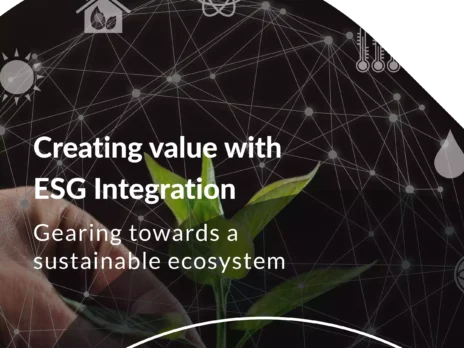
Sustainability is a driving force for change in every industry and financial services is no exception. The environmental, social and governance (ESG) elements of sustainability are manifesting in efforts to boost socially responsible, ethical, sustainable and impact investment, driven in part by the powerful force of regulation.
Take, for example, the European Commission’s sustainable finance disclosure regulation (SFDR), which imposes mandatory and standardised ESG disclosure obligations for asset managers and other financial markets participants.

“I think SFDR will certainly change many things and will help clients mature,” says Ravi Vaidyanathan, president and head of financial services at Hexaware. “More clients are getting acquainted with these regulatory requirements and trying to evaluate data vendors or service providers to reflect their ESG criteria. And the recent SEC announcement of a new proposal to address protection around greenwashing in the US market is quite significant”
“Integrating ESG factors in the investment lifecycle is becoming a high priority for the asset managers or fund managers who are taking investment decisions, and also for asset owners,” he adds.
Regulatory and reporting pressure means ESG is no longer an exercise in box-ticking. It has become a business-critical exercise, which brings many challenges, principally in the area of data management. Firstly, the industry must identify providers of ESG data and integrate ESG scorecards and niche data analytics.
“Taxonomies are evolving, which is a good thing but they are way too many,” observes Vaidyanathan. “Data providers are reaching a stage of maturity; however, the available data is not necessarily aligned with the taxonomies. This makes the ecosystem complex to understand and hence challenging for asset managers to integrate and report.”
Diving into the data
Whether it is the EU Sustainable Finance Taxonomy or any other international or national standard, the data element is fundamental. One big challenge is the profusion of non-digital data. Much publicly available ESG data is unstructured, and ESG disclosures are often in a form that must be read and processed manually, which is a slow and expensive process.
“The other important aspect is there are multiple stakeholders,” says Vaidyanathan. “This data is needed by the back office, the middle office and the front office. To cater for all that, our clients are facing a two or three-year roadmap, and at the same time trying to understand the evolving requirements. That makes it quite challenging.”
“How do we integrate dynamic data with these ESG scores or disclosures, and how do we bring in more intelligence into aggregating the data or bring in self-servicing capabilities to ingest the information that is needed?” he asks. “Digital technologies can play an important role.”
Integrating ESG scores from various vendors and a host of data coming in different forms certainly makes ESG integration a data management issue, but it should not be thought of in such narrow terms. Consideration must be given to how data modelling is done, but at the same time, a more integrated approach is required, guided by taxonomies provided by the Sustainability Accounting Standards Board (SASB), the Global Reporting Initiative (GRI) or the Task Force on Climate-related Financial Disclosures (TCFD).
“We’ve looked at those taxonomies to see how they can be integrated with a focus of getting a normalised view of the ESG data coming from multiple data sources or even manually entered in a way which is in compliance and in alignment with these requirements,” says Vaidyanathan. “However, standardising the metrices against the taxonomies for common reporting is an area which the industry needs to address. The regulators and the market participants, mainly the consortium of asset managers and asset owners, have an active role to play to ensure a transparent and a consistent view.”
“Once this holistic view is obtained in a centralised fashion, then the ability of any firm to assess this data or to create different views for different stakeholders will be much more enhanced,” he adds. “Getting the normalised data is where they’re struggling at the moment.”
Building a sustainable digital platform
There is a need for an end-to-end ESG integration digital platform that has a built-in taxonomy framework, which allows for standardising the data elements, that incorporates the firm’s sustainability policies and targets are integrated as well, that create a more unified view of the ESG data for actionable insights.
Its goal should be to enable firms to drive ESG goals while meeting investor expectations and ensuring regulatory compliance, and the core objective is to support clients in managing ESG risks, integrating ESG into investment decisions, complying with regulatory requirements like SFDR, and fulfilling net zero and other climate action commitments.
“Building a very strong foundation with a holistic point of view provides the ability to deal with complexities of evolving regulatory policies and requirements, based on a foundational layer with strong data management capabilities,” Vaidyanathan explains. “We believe a centralised core engine for ESG, able to take in requirements for multiple stakeholders will be the key here.”
“Our focus is around ESG integration solutions supporting a comprehensive, form-based service, which will enable them to integrate ESG for various use cases,” he adds. “Our focus is on the foundation layer – enhancing data management and analytical capabilities. However, we are not just looking at ESG as another data set – we have built a capability to integrate global taxonomies and industry standards along with clients’ own sustainability policies, proprietary classifications and weightage. We believe this will enhance the client’s ability to truly aggregate, measure and assess ESG factors to generate actionable insights and make informed decisions.”
Hexaware has built a team of ESG-certified experts to help in the design and development of these models. In addition, under its Mobiquity umbrella, the company specialises in enabling its clients to conceptualise, design, create and launch new digital channels for selling their products and services, tailored specifically for ESG needs.
“How much of the decarbonisation do they want to do at a portfolio level?” asks Vaidyanathan. “What about renewable energy? What are their investment targets? Clients are not jumping in and taking the shortest path. They want to assess where they are. We provide a tool-based approach to ESG integration because an organisation’s ability to innovate, scale and collaborate will be the key to mitigating implementation risks and faster time-to-market”
With the platform in place, clients can then focus on gaining a competitive edge with new revenue streams by creating ESG-enabled business models, products, and services








